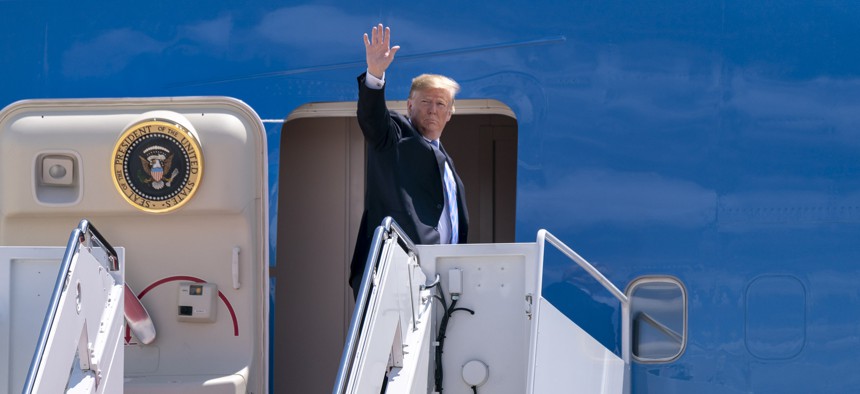Lawmakers Want the Final Say on Air Force One Paint Job
A House panel has drafted legislation that would require congressional approval if Trump wants to change the Kennedy-era livery.
Some U.S. lawmakers want the final say if President Trump decides to change Air Force One’s paint job from the blue-and-white livery that has adorned presidential planes for more than a half century.
Last year, Trump told CBS News that he wants to paint the new planes “red, white and blue, which I think is appropriate.”
But the House Armed Services seapower and projection forces subcommittee — in its review of the Pentagon’s 2020 budget request — has drafted legislation that would require the plane’s paint job to “comply with the criteria set forth in a report of the Boeing Company titled ‘‘Phase II Aircraft Livery and Paint Study Final Report’ as submitted to the Federal Government in April 2017.”
What’s in that report? Boeing declined to comment.
Asked about it, a congressional staffer said, “There were some rumors some time back about proposed changes to the paint job on Air Force One. This language would prevent expenditures on those sorts of changes without Congressional approval.”
The proposed legislation also contains various clauses intended to prevent more expected price hikes in the effort to replace the two 1990s-era jetliners currently used for presidential travel. Initially projected to cost about $4 billion, the estimated price tag for the two planes, extensive modifications and new hangars currently stands around $5.3 billion. Still, Trump and the Air Force claim $1.4 billion in savings.
The subcommittee is led by Rep. Joe Courtney, D-Conn., who has long kept a close eye on efforts to upgrade and replace the presidential jets. Last year, Courtney questioned a $24 million no-bid contract given to Boeing to install new refrigerators on the current Air Force Ones. The Air Force eventually scrapped the refrigerator deal, which Courtney said “just didn’t pass the smell test.”
The congressional staffer said the subcommittee’s Air Force One legislation was “routine oversight of the purse strings, and ensuring that we’re exercising fiscal responsibility when it comes to an aircraft that’s already expensive to outfit in every scenario in the first place.”
Even before Trump moved into the White House, he had criticized the high price tag of replacing the pair of Boeing 747-200s that have served as Air Force One since 1990. In an effort to reduce the cost, the Air Force bought two 747-8s built for but never delivered to a Russian airline.
Last year, the Air Force awarded Boeing a $3.9 billion contract to convert those planes into customized flying White Houses. In March, the two 747-8s were flown from a storage airfield in Victorville, California, to a company modification factory in San Antonio, Texas.
The new Air Force One is expected to enter service in late 2024, so a decision about its paint job won’t be needed for a number of years. Planes are typically painted at the very end of the manufacturing process.
“This is just about ensuring that when we do make expenditures on these aircraft, there is some oversight to ensure that they’re being made for the right purposes and with the signoff of Congress,” the congressional aide said.
Because the new 747-8s are larger than the 747-200s they will replace, the Air Force must build a new secure hangar complex. In December, it awarded Clark Construction Group $298 million to build the new facility at Joint Base Andrews in the Maryland suburbs of Washington.








